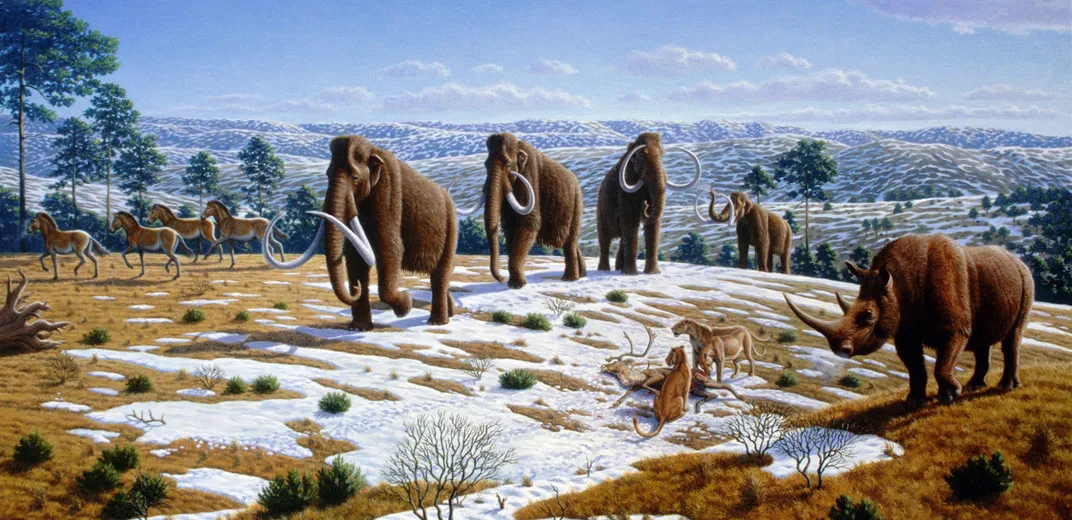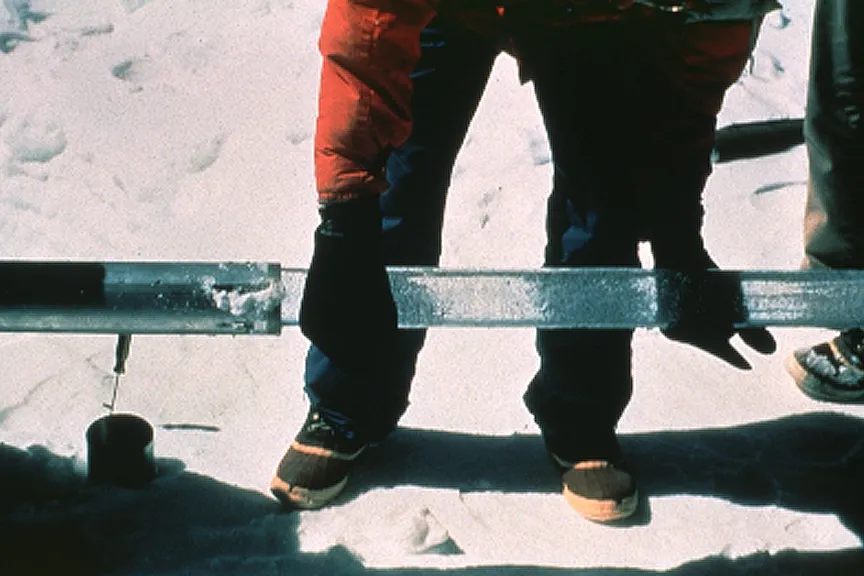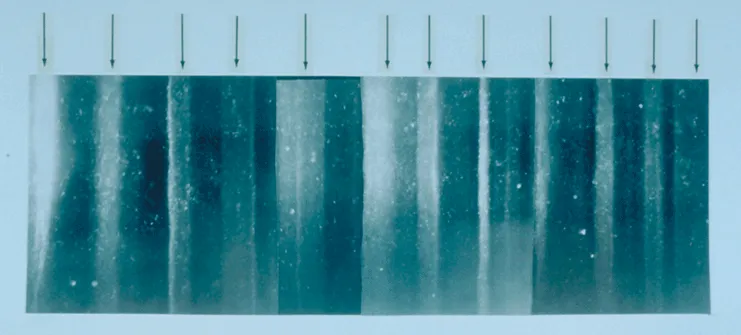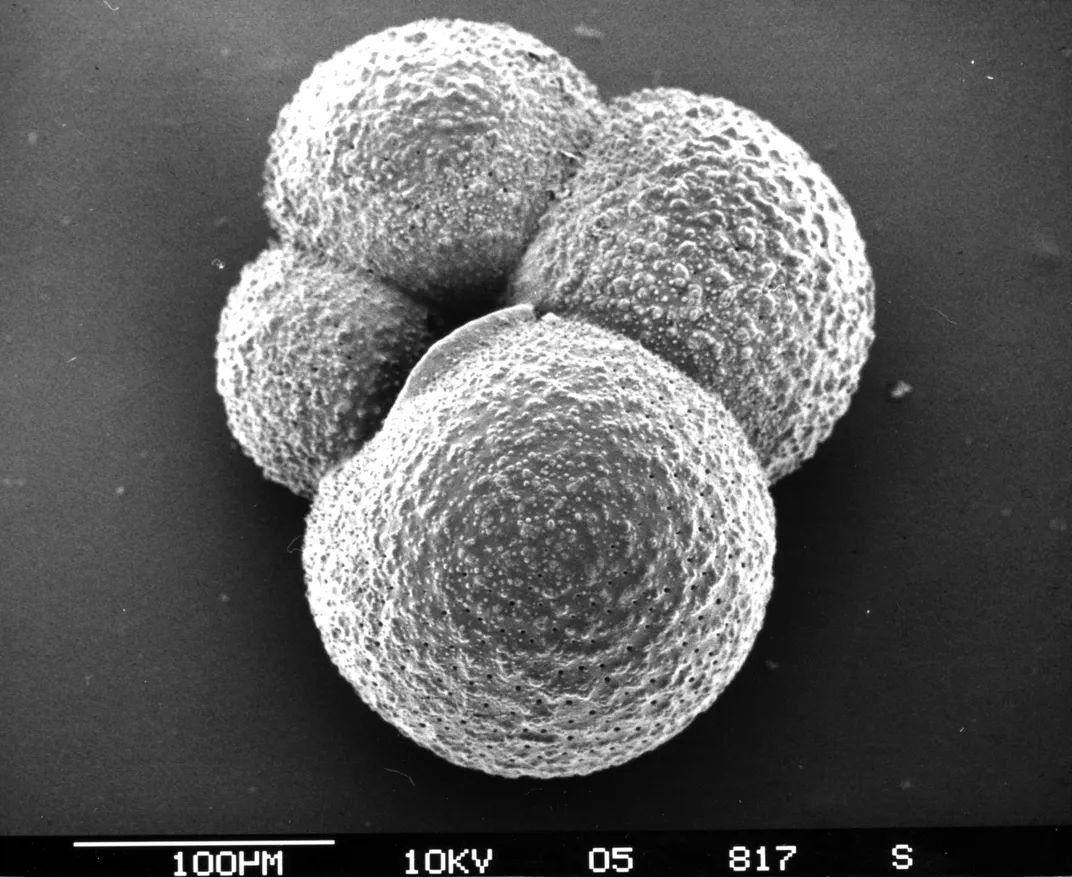How Do We Know About Atmospheric Makeup And Temperature In The Past
/https://tf-cmsv2-smithsonianmag-media.s3.amazonaws.com/blogging/featured/Haeckel_Thalamphora-002--saved-for-web.jpg)
Paleontologists have long recognized the power of using fossils preserved in the rock record to reconstruct the Globe's past environments and climates. Today, animals and plants are associated with specific environments or climates - cactuses grow in dry deserts while polar bears alive in cold northern latitudes. These same associations in the by provide a full general understanding of how Earth's climate has changed over the by 542 million years (the duration of the fossil tape for complex life).
For instance, the discovery of fossil palm tree stumps in Alaska and the unearthing of fossil alligator remains in the Arctic Circle suggested that the high latitudes were a tropical landscape 52 million years agone. Curator Scott Wing and postdoctoral fellow Richard Barclay with colleagues at the Smithsonian's National Museum of Natural History have looked at how establish communities and constitute traits track long-term changes in the climate. Fieldwork in at present-arid Namibia has uncovered dropstones—large chunks of rock frozen to the underside of icebergs that are dropped into the ocean equally the water ice moves and melts. These dropstones were plant in 650-million-year-sometime rocks, providing evidence that glacial conditions extended downwardly to the equator at this time. But how do scientists really take the temperature of ancient Earth from the geologic record?

Although fossil communities and geological indicators like dropstones tell u.s. if times were relatively warm or cool, they are coarse interpretations of the environment. Amalgam a more finely detailed temperature curve is by no means a straightforward job. In our daily lives, we mensurate the outside air with tools similar infrared probes or mercury-filled glass tubes to determine temperature in absolute ways using units such equally degrees. Once we agree on a scale and understand how our tools reflect changes in temperature, anyone measuring temperatures along the same scale will know just how hot or cold something is. Our records of temperature using these modern tools go back hundreds of years. Still, to look back even farther in time, before humans were recording the temperature as they experienced it outside, we have to report the geologic record.
One mode to measure past temperatures is to study ice cores. Whenever snowfall falls, small bubbles filled with atmospheric gases get trapped within it. In some places, so much snowfall falls that the older layers become buried and compressed into ice, locking away air bubbles in ice sheets and glaciers. With extremely careful drilling, we tin excerpt long ice cores from these features to study the thousands of layers ice representing divide snowfalls and their trapped air bubbles. In controlled laboratory environments, we tin can measure the chemical makeup of the air that has been trapped - how much oxygen, carbon dioxide, and nitrogen gas was present in the atmosphere at the fourth dimension it was buried in the ice. From these measurements, we tin can calculate by temperatures using empirical data on how these gases hold rut in the modern temper. The temperature tape recovered from ice cores goes dorsum hundreds of thousands of years from glaciers that accept persisted on landmasses similar Greenland and Antarctica. All the same, ice sheets come and go and the oldest glacier is no older than a few million years. To get even older temperatures, we can't only rely on what we tin acquire from water ice.


The about common method for measuring temperatures of aboriginal Earth uses naturally occurring isotopes. Isotopes are atoms of the aforementioned chemical element that are heavier or lighter depending on how many neutrons are in its nucleus. Even molecules of water, composed of i hydrogen atom and two oxygen atoms, can have different weights depending on what isotopes of hydrogen and oxygen are bonded together. The 2 most common isotopes of oxygen in nature are oxygen-16 (viii neutrons) and oxygen-eighteen (ten neutrons). When the World cools down, the lighter, oxygen-sixteen found in seawater is locked abroad in the water ice of loftier breadth glaciers due to evaporative processes, leaving behind relatively more than oxygen-18 in the oceans. During warm global climates, melted ice returns oxygen-16-rich waters to the oceans. So the proportion of oxygen-18 to oxygen-xvi in the ocean reflects the Earth'due south climate even if nosotros can't run across the water ice. Globe Scientists recognize this oxygen isotope pattern betwixt glaciated and water ice-free climates, referring to it as the "ice volume effect", and take since used it to reconstruct aboriginal Globe climates.
Oxygen isotope records are as well preserved in the shells of marine organisms and the proportion of oxygen-16 and oxygen-18 can be revealed by analyzing the chemistry of pristine fossils. The fossils of larger organisms like corals or clams tin can be especially informative for revealing almanac and seasonal temperature variations considering these marine animals live for multiple years secreting season growth bands in a similar style to tree rings. However, well-preserved clams and corals can be geographically constrained, occurring only in the tropics or in near-shore environments. The true heavyweights for reconstructing ancient seawater temperatures are the microorganisms. Foraminifera, unmarried-celled organisms roughly the size of the period ending this judgement, occur nearly everywhere in the oceans and have an exquisite fossil record. Thus, the fossil shells of foraminifera tin can provide a more complete agreement of the aboriginal body of water's conditions beyond all latitudes and at almost water depths. By measuring the oxygen isotope ratio in foraminifera, scientists like Brian Huber, a curator at the Smithsonian'due south National Museum of Natural History, can reconstruct body of water temperatures more than 100 meg years ago. Although they can fill in the gaps where macroorganisms are non preserved, foraminifera are unable to provide seasonal temperature records, highlighting the value of scientists working together on different aspects of the fossil record to build coherent records of the ancient climate.

Thermometers, ice cores, isotopes. Because each of these approaches measures slightly different things - atmosphere versus ocean, gases versus isotopes, temperatures hundreds of years ago versus temperatures millions of years agone, seasonal versus almanac versus time-averaged temperatures - matching them up with ane some other and building one continuous record of temperature through Globe's history is a difficult task. This problem becomes even harder as nosotros move farther dorsum in time because our ability to assign an exact age to a measurement decreases. To ensure we brand the most accurate measurements possible, each proxy requires a specific expertise in the field and in the lab in addition to an understanding of how these methods piece of work in modern settings through empirical observations and/or experimentation. Because these proxies tell us slightly different stories, scientists applying different methods to the geologic tape with the same goal of amend agreement and quantifying ancient World's temperatures must collaborate to tell the complete story of our planet's by. Events like the Paleoclimate Symposium at the Smithsonian'south National Museum of Natural History provide forums in which scientists tin can share their noesis, hash out these issues, and accomplish a working consensus as a customs.

How Do We Know About Atmospheric Makeup And Temperature In The Past,
Source: https://www.smithsonianmag.com/blogs/national-museum-of-natural-history/2018/03/23/heres-how-scientists-reconstruct-earths-past-climates/
Posted by: wellsdresse.blogspot.com


0 Response to "How Do We Know About Atmospheric Makeup And Temperature In The Past"
Post a Comment